Essbase and EPM Integration Improvements in OBIEE 11.1.1.7
One of the major new feature areas in OBIEE 11.1.1.7, but which has so far got very little attention, is the significant improvement in integration between Essbase, the Hyperion EPM Suite, and OBIEE 11g. The integration between EPM Workspace and OBIEE's Presentation Services which disappeared when 11g came along is now back, along with installation and security integration, a new version of SmartView that (properly) supports OBIEE as a data source, and the ability to spin-off aggregates from the RPD into Essbase ASO cubes.
Now some of these features of course made an appearance in the earlier, 11.1.1.6.2 BP1 release, and integration between OBIEE 11g and EPM Suite has been happening on-and-off right back from the OBIEE 10g days, but where we're at now with OBIEE 11.1.1.7 is the delivery of a number of things that customers have long been asking for, including:
- The ability to run OBIEE from within EPM Workspace, with single sign-on between the two
- Shared security provisioning and organisation between Essbase and OBIEE, through application roles and policies
- The ability to install Essbase and the other EPM tools into the same WebLogic domain as OBIEE, using a single installer
- A proper Excel (and Word, Powerpoint, Outlook) add-in for OBIEE, with the ability to author reports as well as run existing Answers-authored ones
This is actually one of a number of new feature areas that came with 11.1.1.7 that have had little publicity; as well as better Essbase integration, there's actually now support for multi-tenancy in the RPD and catalog, Hadoop integration (which we covered in a blog post last week), the View Suggestion Engine, the inevitable changes to MUD, and quite a few others, some of which I'll try and cover in the next few days and weeks, but for now let's look at these new Essbase/EPM integration improvements, starting with installation of Essbase and its related tools into the OBIEE WebLogic domain.
As I mentioned back in my OBIEE 11.1.1.7 New Features posting a few weeks ago, the OBIEE product installer now offers Essbase as an installation option alongside OBIEE, Real-Time Decisions (RTD) and BI Publisher. As with RTD, Essbase isn't included in the base OBIEE+ license, but it is included in Oracle BI Foundation Suite, the product package that Oracle encourage new customers to take out an includes OBIEE, Scorecard & Strategy Management, Essbase and BI Mobile. Selecting Essbase during the install process installs it, and the other EPM Suite tools, in the same WebLogic domain as OBIEE, and you can see Essbase within Fusion Middleware Control as a product - separate from OBIEE - that you can manage and monitor.
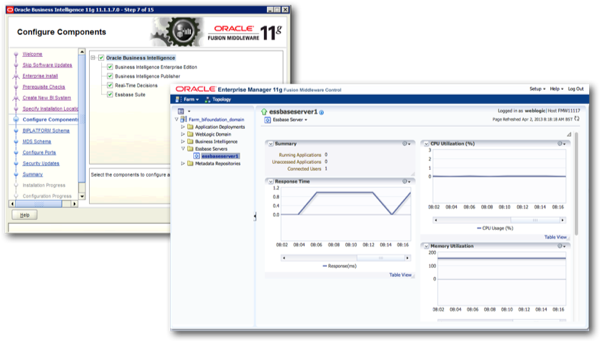
Essbase Server, and Essbase Studio (the client/server tool used to design and build Essbase cubes) are also now controlled and monitored through OPMN, something that's been a feature of EPM Suite for several releases now but which is, of course, new for OBIEE.
[oracle@obiee11117 ~]$ cd /home/oracle/obiee/instances/instance1/bin
[oracle@obiee11117 bin]$ ./opmnctl status
Processes in Instance: instance1
---------------------------------+--------------------+---------+---------
ias-component | process-type | pid | status
---------------------------------+--------------------+---------+---------
essbasestudio1 | EssbaseStudio | 12682 | Alive
essbaseserver1 | Essbase | 12685 | Alive
coreapplication_obiccs1 | OracleBIClusterCo~ | 12686 | Alive
coreapplication_obisch1 | OracleBIScheduler~ | 12687 | Alive
coreapplication_obijh1 | OracleBIJavaHostC~ | 12683 | Alive
coreapplication_obips1 | OracleBIPresentat~ | 12684 | Alive
coreapplication_obis1 | OracleBIServerCom~ | 12689 | Alive
[oracle@obiee11117 bin]$
So something that's been an issue for EPM customers upgrading from OBIEE 10g to 11g was the removal, at the time, of the ability to integrate OBIEE's Presentation Services within EPM Workspace, and the SSO link between the two products. Back with OBIEE 10.1.3.4 there was an admittedly complicated but supported and working process to integrate the two products together, allowing EPM Workspace customers to "skin" OBIEE to look like Workspace and run the two products together, albeit with separate report catalogs, security models and so forth.
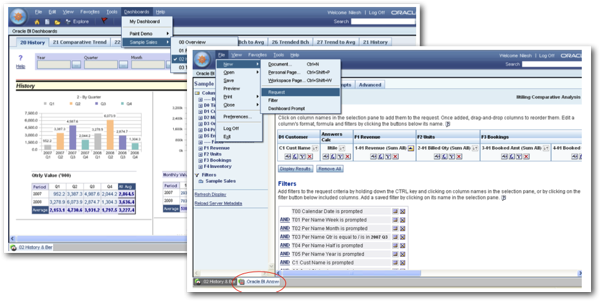
This, coupled with the removal of OBIEE's Hyperion custom authenticator for the RPD left many EPM Suite customers upgrading to OBIEE 11g in the lurch, leading to workarounds such as this one that we put together recently for one of our customers. Well this integration (mostly…) is back with OBIEE 11.1.1.7, so let's see what it does, and what functionality is still missing compared to OBIEE 10g.
First off, Essbase and EPM Suite as installed as part of an OBIEE installation isn't quite the same as EPM Suite installed standalone; most importantly, Essbase in this OBIEE incarnation has a different security model than "standalone" EPM Suite, in that it uses the same system of application roles and policies that the Fusion Middleware 11g-centric OBIEE 11g does, rather than the Shared Services and groups that standalone EPM Suite does. Also, the OBIEE 11.1.1.7 install installs just the following EPM Suite products:
- Essbase Server, including Essbase Agent, Essbase Studio, Essbase Administration Services, Provider Services
- Financial Reporting
- Calculation Manager
Therefore you don't get Planning, Web Analysis and so forth, and you can't subsequently install them into the domain and Fusion Middleware Control afterwards - so think of Essbase and the EPM Suite tools in this context as an add-on and complement to OBIEE, not a full installation of EPM Suite in their own right. Moreover, the majority of Essbase administration tasks which for standalone EPM Suite installs are performed through MaxL, Shared Services and EAS are performed through Fusion Middleware Control, and Essbase high-availability and clustering works different within this context, for example. The standard product architecture diagram for OBIEE and Essbase combined within the 11.1.1.7 release therefore gets updated, with a number of products added to the Java components, and System components part of the diagram, like this:
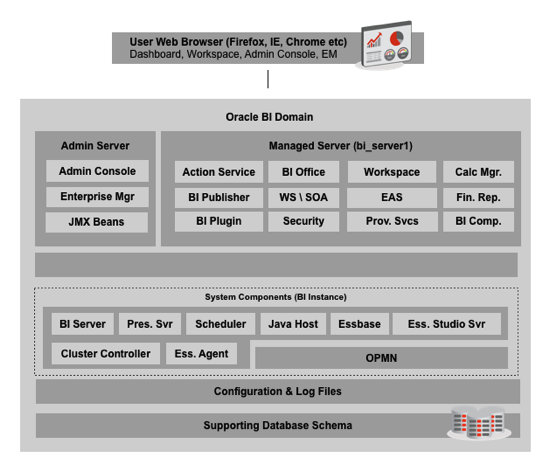
Now, when installed as part of OBIEE 11.1.1.7's WebLogic domain, EPM Workspace is available at http://[machine_name:port]/workspace, and when you launch it you're presented with a view into the BI Catalog, and menu options to administer the various EPM and BI tools from one place.
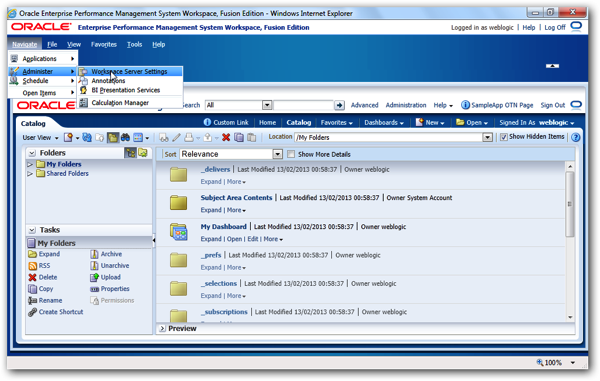
Within this catalog are both OBIEE objects such as analyses, dashboards and agents, and EPM objects such as Financial Reporting and SmartView reports.
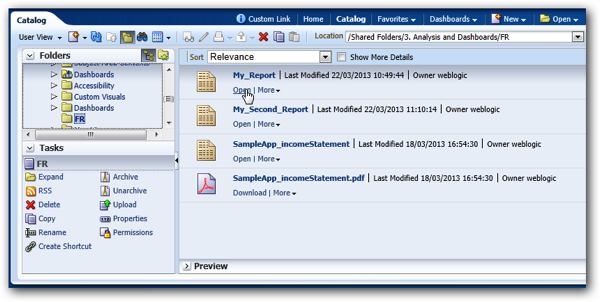
There are limits to this EPM/BI Catalog integration though - FR reports, for example, can only be opened using the File > Open dialog in EPM Workspace, with an error message showing if you just click on the report itself in the BI Catalog view within EPM Workspace. But SSO between Workspace and OBIEE seems to work (as in, you don't need to re-enter your BI password when clicking on an analysis in the Workspace Catalog view) as both OBIEE and EPM are working off of the same Fusion Middleware security model, which (the lack of) explains why the feature disappeared for so long after OBIEE 11g was introduced.
Now that OBIEE and Essbase share the same security, the need for the old HSS Custom Authenticator has now gone away, though of course this will only be of use if a customer has moved their Essbase installation into the OBIEE domain, with standalone EPM Suite installations still needing the security workaround mentioned earlier in this article. There's no upgrade path from standalone EPM Suite installations to this integrated arrangement, so most probably any users of Essbase within this new 11.1.1.7 context will be installing it "net-new", with the main objective being to enhance their existing BI setup rather than merging their separate BI and EPM platforms into one.
As you've probably picked-up by now, much of this new integration ability is down to security harmonised across both Essbase and OBIEE, or more accurately Essbase now having an option to use Fusion Middleware 11g security rather than Hyperion Shared Services. So what does Essbase and FMW11g security look like in practice? Let's head over to Fusion Middleware Control, in particular the Application Policies administration screen, to take a look.
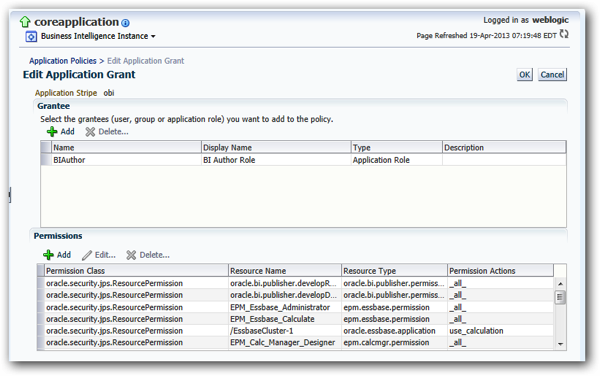
The big difference when Essbase runs as part of an Oracle BI domain is that authentication, and authorization for Essbase use Fusion MIddleware security rather than Shared Services or Native Essbase security. Although Essbase Administration Services ships with OBIEE 11.1.1.7, you should use Fusion Middleware Control to enable access to particular Essbase databases, and give permission to access tools such as Financial Reporting or Administration Services; the only security role for EAS and MaxL in this setup is to create the Essbase data and metadata filters; these filters are then assigned to users through FMW security resource permissions and application policies, which then are then granted to application roles and thereby to users.
Whilst this probably seems like an over-complicated nightmare to traditional Essbase users, it does have the major advantage that one set of application roles granted to users within a Fusion Middleware system can cover both OBIEE and Essbase permissions, and there's no need to link to Shared Services or support Native Essbase security. We'll cover the implications of this more in some future blog posts, but this is the enabling technology that makes the rest of this integration make sense.
With Essbase integrated into the OBIEE BI Domain, you can also now use Essbase as an aggregate persistence target, though this feature comes with the same (slightly strange) approach and limitations that we first encountered when it was first introduced with OBIEE 11.1.1.6.2 BP1; although there's not the same requirement for the Essbase server only to be used for aggregate persistence, you still have to name the Essbase database in a particular way, it's ASO-only, and the Aggregate Persistence Wizard still creates a separate ASO database for each aggregation (similar to Oracle Database materialised views) rather than one single cube covering all aggregations. In practical terms - I'm not sure how much you'd use this vs. creating your own Essbase cube in Studio against the whole RPD business area - but it might be useful for OBIEE developers who otherwise don't know Essbase.
So finally, the other major Essbase-related new feature in OBIEE 11.1.1.7 is SmartView, the successor to Oracle BI Office. But that's a topic in itself, so I'll cover that this in the next posting.